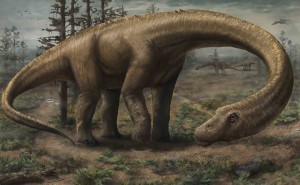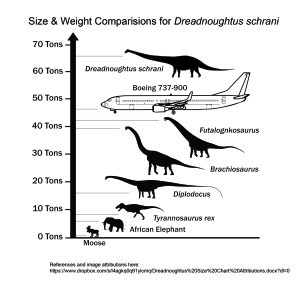Kenneth Lacovara discovered Dreadnoughtus schrani in 2005 in Santa Cruz Province, Argentina, in southernmost Patagonia. At 85 feet (26 m) long and weighing about 65 tons (59,300 kg) in life, Dreadnoughtus is the largest land animal for which a body mass can be accurately calculated. Its skeleton is exceptionally complete, with over 70 percent of the bones, excluding the head, represented. Because all previously discovered super-massive dinosaurs are known only from relatively fragmentary remains, Dreadnoughtus offers an unprecedented window into the anatomy and biomechanics of the largest animals to ever walk the Earth.

Lacovara and colleagues published the description of their discovery, defining the genus and species Dreadnoughtus schrani, in the open-access Nature journal Scientific Reports. The new dinosaur belongs to a group of large plant eaters known as titanosaurs. The fossils were unearthed over four field seasons from 2005 through 2009 by Lacovara and a team including Argentinean and US collaborators, as well as students and volunteers.
One hundred forty-five elements of the Dreadnoughtus skeleton are represented, including most of the 30-foot-long tail, neck vertebrae (one with a diameter of over a yard), forelimbs and hindlimbs, shoulder bones, numerous ribs, toes, a claw, a small section of jaw and a single tooth. A smaller individual with a less-complete skeleton was also unearthed at the site.
 Astoundingly huge
Astoundingly huge
Dreadnoughtus weighed as much as a dozen African elephants or more than seven T. rex. Shockingly, skeletal evidence shows that when this 65-ton specimen died, it was not yet full grown.
The ‘gold standard’ for calculating the mass of quadrupeds (four-legged animals) is based on measurements taken from the femur (thigh bone) and humerus (upper arm bone). Because the larger Dreadnoughtus specimen includes both these bones, its weight can be estimated with confidence. Prior to the description of the 65-ton Dreadnoughtus specimen, another Patagonian giant, Elaltitan, held the title of dinosaur with the greatest calculable weight at 47 tons, based on a recent study. Overall, the Dreadnoughtus schrani is represented by 70.4 percent of the types of bones in its body, excluding the skull.
To better visualize the skeletal structure of Dreadnoughtus, Lacovara’s team digitally scanned all of the bones from both dinosaur specimens. A virtual mount of the skeleton is available for download at FigShare. The 3D laser scans of Dreadnoughtus show the deep, exquisitely preserved muscle attachment scars that can provide a wealth of information about the function and force of muscles that the animal had and where they attached to the skeleton.
A Dinosaur that Feared Nothing
With a body the size of a house, the weight of a herd of elephants, and a weaponized tail, Dreadnoughtus would have feared nothing. To Lacovara, it evoked a class of turn-of-the-last century battleships called the dreadnoughts, which were huge, thickly clad and virtually impervious. Thus, he chose the name “Dreadnoughtus,” meaning “fears nothing. The species name, “schrani,” was chosen in honor of American entrepreneur Adam Schran, who generously provided support for the research.
Dread FAQs
Q: Is Dreadnoughtus schrani the world’s largest dinosaur?
A: Sauropod dinosaurs (long-necked plant eaters) include the largest land animals that have ever existed. Multiple studies have shown that the body weight of a quadrupedal (four-legged) animal corresponds closely with measurements taken from its humerus (upper arm bone) and femur (thigh bone). Many paleontologists consider this approach to be the only reliable method of calculating the weight of an extinct quadrupedal creature, such as a sauropod. There are a number of extremely large dinosaurs, but many of these are based on very incomplete fossils that lack a humerus and/or a femur. As such, their body weight is impossible to calculate with this method. Thus, Dreadnoughtus has the largest calculable weight of any known land animal.
Q: How big was Dreadnoughtus?
A:
| Weight | 65 tons (59.3 metric tons) |
| Total length | 85 feet (26 m) |
| Head & neck length | 40 feet (12.2 m) |
| Neck length | 37 feet (11.3 m) |
| Torso and hip length | 17 feet (5.1 m) |
| Tail length | 29 feet (8.7 m) |
| Height (at shoulder) | 2 stories |
Q: How does Dreadnoughtus compare to the giant ‘Titanosaur’ from Patagonia, whose replica is displayed at the American Museum of Natural History?
A: “Titanosaur” refers to a group of dinosaurs, not a species. Dreadnoughtus is also a titanosaur. The scientific community has not yet vetted the multiple specimens for which the American Museum replica is based. In other words, information on these fossils has not yet been the subject of a peer-reviewed, published study. Without published measurements, it is impossible to compare these specimens to others.
Q: Is Dreadnoughtus larger than Argentinosaurus?
A: Argentinosaurus is an extremely large dinosaur and a contender for the most massive land animal yet discovered. However, Argentinosaurus is based on very fragmentary remains (only 13 bones out of approximately 250 in a whole skeleton), from which a reliable mass estimation is impossible.
Q: When was Dreadnoughtus discovered?
A: February of 2005
Q: Who discovered Dreadnoughtus?
A: Kenneth Lacovara discovered the dinosaur while prospecting for fossils in Santa Cruz Province, Argentina. Lacovara spotted a small patch of bones and recorded the location with his GPS. The team returned a few hours later and began excavating. By the end of the day, they had exposed about ten bones of what would come to be known as Dreadnoughtus schrani.
Q: How many bones of Dreadnoughtus were found?
A: After four expeditions, the team had excavated a total of 145 bones and a single tooth representing two individuals of Dreadnoughtus schrani– 115 bones (and the tooth) from the larger specimen and 30 bones from a second, smaller individual.
Q: How complete is the skeleton of Dreadnoughtus?
A: Completeness may be assessed in different ways. Sauropod dinosaur skeletons are often recovered with little to no skull material, so completeness is often looked at in terms of postcranial completeness (i.e., the completeness of the skeleton excluding the skull). Completeness may also be assessed in terms of numbers of bones versus types of bones. The most important metric for understanding the anatomy of a fossil animal is types of bones. The completeness metrics for Dreadnoughtus schrani are as follows:
- 116 bones out of ~256 in the entire skeleton (including the skull) = 45.3 percent complete
- 115 bones out of ~196 in the skeleton (excluding the skull) = 59 percent complete
- 100 types of bones out of ~142 types in the skeleton (excluding the skull) = 70.4 percent complete
Q: How does Dreadnoughtus compare in terms of completeness with other super-massive dinosaurs?
A: Prior to the publication of Dreadnoughtus schrani, the most completely known super-massive titanosaur was Futalognkosaurus dukei, which is represented by 15.2 percent of the total skeleton and 26.8 percent of the types of bones in the skeleton (excluding the skull). Argentinosaurus is known from only 5.1 percent of the entire skeleton and 9.2 percent of the types of bones in the postcranial skeleton. Thus, the skeleton of Dreadnoughtus schrani is more complete than those of all other super-massive dinosaurs.
Q: How old were the Dreadnoughtus individuals at the time of their death?
A: The exact ages of these two individuals are not clear. However, multiple lines of evidence indicate that the larger Dreadnoughtus was growing rapidly at the time of its death. The shoulder bones of this individual are not fused together, as would be expected in a mature adult. Furthermore, microscopic analysis of the bones of this specimen revealed none of the cellular structures expected in a mature individual. Shockingly, at the time of its death, the 65-ton Dreadnoughtus was still growing fast.
Q: How did the Dreadnoughtus individuals die?
A: There is no evidence of traumatic injury for either individual. There are a few tooth marks on a single vertebra that likely represent scavenging by a much smaller meat-eating dinosaur. It appears that both individuals died and were buried rapidly after a river flooded and broke through its natural levee, turning the ground into a soupy mixture of sand, mud and water. The rapid and deep burial of the larger Dreadnoughtus schranispecimen accounts for its extraordinary completeness.
Q: How was Dreadnoughtus transported to the United States?
A: In the field, the bones of Dreadnoughtus were ‘ jacketed’ in burlap and plaster to protect them during transportation. Because some bones were fragmented into more than one piece, a total of 234 plaster jackets, weighing 16 tons, were created. The jackets were loaded into a cargo container and shipped by sea to Philadelphia on the Hamburg Süd freighter Cap San Lorenzo. The voyage took approximately six weeks and Dreadnoughtus visited a dozen ports along the coast of South America on its journey. The fossils arrived in Philadelphia on May 9, 2009.
Q: What happened to the fossils after their arrival?
A: Fossils shipped in plaster jackets require a lot of work, or preparation, before they can be safely studied. Dreadnoughtus was shipped in more jackets than any one lab could handle, so the material was divided into thirds and shipped to Carnegie Museum of Natural History in Pittsburgh, The Academy of Natural Sciences, and Lacovara’ s lab (then at Drexel University.)In 2012, all of the fully cleaned and restored material was reunited in Dr. Lacovara’ s lab for study.
Q: How were the bones of Dreadnoughtus turned into 3D images?
A: All of the bones of both Dreadnoughtus specimens were scanned in Lacovara’s lab with a NextEngine 3D laser scanner. Using the software Autodesk Maya, the scans of each bone were positioned in 3D space to create a digital articulated skeleton, which was then converted into 3D PDF files using the software GeoMagic.
Q: Can anyone access the 3D images of Dreadnoughtus schrani?
A: Yes. Lacovara et al. published 3D PDF files of the entire skeleton and selected bones in the supplementary section of their paper. The files may be used by anyone with access to Adobe Reader software, which is freely available for download here: http://get.adobe.com/reader/. In Adobe Reader, the viewer can zoom in and out on theskeleton, rotate the view, and turn individual bones on and off. The 3D PDF files of
Dreadnoughtus may be downloaded here: http://dx.doi.org/10.6084/m9.figshare.1130885.
Q: Is there additional research underway on Dreadnoughtus?
A: Yes. Lacovara’ s research group and colleagues have numerous studies in progress. The Sept. 4, 2014 paper describing Dreadnoughtus schrani established the new genus and species and described the unique features of its anatomy. Subsequent papers will focus on topics including the musculature, biomechanics, growth rate, and the biomolecular preservation of the Dreadnoughtus specimens.
Q: Who owns Dreadnoughtus?
A: The Province of Santa Cruz, Argentina. In March 2015, the specimens were returned to the Museo Padre Molina in Río Gallegos, Argentina, where they will permanently reside.
Q: Can anyone access the paper by Lacovara et al. describing Dreadnoughtus schrani?
A: Yes. The paper is published in the open access, online journal Scientific Reports(published by Nature Publishing Group) and may be freely viewed and downloaded here: http://dx.doi.org/10.1038/srep06196.
A PDF containing supplementary data can be found here:
http://www.nature.com/article-assets/npg/srep/2014/140904/srep06196/extref/srep06196-s1.pdf
Altmetric scores for the Lacovara et al. 2014 Dreadnoughtus paper are as follows:
- In the top 5% of all research outputs scored by Altmetric
- One of the highest-scoring outputs from Scientific Reports (#7 of 15,556)
- High score compared to outputs of the same age (99th percentile)
- High score compared to outputs of the same age and from Scientific Reports (99th percentile)
©Kenneth J. Lacovara